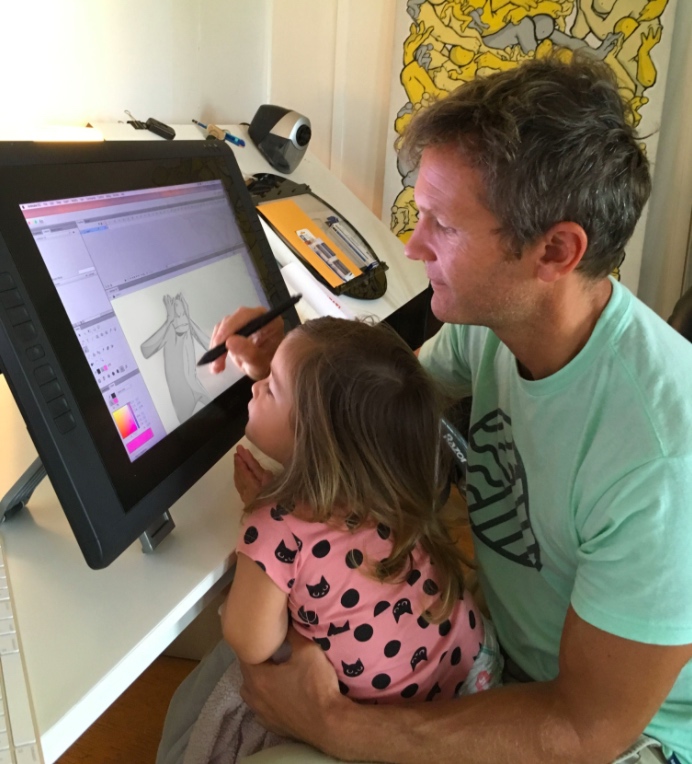

Working From Home Has Led To The Most Productive Era Of My Animation Career
Cartoon Brew is launching today a new opinion section focused on the thoughts and perspectives of professionals working throughout the animation world. In our first op-ed, filmmaker Patrick Smith, who used to work in-house at New York animation studios and later ran his own commercial studio in Manhattan, has penned advice on why and how he works more productively at home — something that he has been doing for the last six years. In the last decade, he has produced and directed over 15 independent award-winning short films and directed the PBS web series Blank on Blank. His latest film Beyond Noh had been slated to premiere next month at Tribeca Film Festival before the postponement of the event. In 2018, he went into a self-induced two-month isolation to create Pour 585 (image at top, video below), which has garnered over 21 millon views on Youtube. Over to Smith:
I’ve been working from home since 2014. This has been the most productive era of my career. It was a difficult adjustment at first, but once the habit got locked in place, I realized the potential for immense productivity, beyond what most people think is possible.
Working from home is more difficult than most think. The lack of accountability requires a new level of discipline. Right now it’s easy to spend hours reading about the pandemic, checking email/Facebook, listening to news, or snacking in the kitchen. These elements are all the enemies of productivity at home. Nobody is next to you to tell you to get to work, and your boss is probably far away in their own locked-down bunker.
Here are some work-at-home productivity tips, which have proven very effective for me and other artists I have worked with in the past. They should be easier to do in the current situation of social distancing — a silver lining, if you want to see it.
1. Go to bed early, get up early, punch out early.
It has been shown in neurological studies that our brains function better in the morning, particularly after a good night’s sleep. But that’s only the beginning of the advantages to becoming a lark. The world is quiet in the morning: email is silent, family is asleep, the world outside hasn’t woken up yet. It is a perfect time for the key element to working from home: focusing without interruption.
Six years ago, I started to wake up at 6 a.m. It was so effective that I moved it to at 5 a.m. For the last three years, I’ve been waking up at 4 a.m. Another advantage to starting early is that you can stop early. I’ve found that working four hours in the morning is roughly equivalent to working eight hours during the day. Also, punching out early is a great way to reserve brain power for other things, like spending time with your family, cooking, hobbies, and enjoying life. As artists, if we’re not careful, our work will easily take over our lives.
One last thing: you can’t wake up early if you don’t go to bed early. This shouldn’t be a problem in a pandemic-induced lockdown. Turn off the tv and go to bed by 9 p.m.
2. Get dressed or don’t…but establish a routine.
A lot of people who work from home claim it’s important to get dressed like you’re going to an office. But what they are really expressing is the importance of establishing a routine that puts you in the working mindset. If this is getting dressed, great! But any routine will work. Routines create habits, and habits are the magical thing that will triple your productivity, especially when working from home.
3. Reserve a separate room for your studio — or get good headphones.
I’m fortunate to have a converted garage as a studio. This allows me to have a small commute every morning, and separates me mentally from my house (particularly the kitchen, which is arguably the biggest obstacle to being productive at home). The basic reason is to avoid interruption and increase your focus. For those of us with families, this is key. If you don’t have a separate room, good-quality noise-canceling headphones can accomplish the same thing.
4. If you listen to podcasts, favor the long ones.
Few things will kill your productivity more than searching for something new to listen to every ten minutes. One of the reasons I love podcasts like Joe Rogan’s is that they’re two to three hours long! I also love audio books and talk radio — again, because they just go on and on. Better yet, ditch the spoken word and just listen to music or ambient sound. Of course, as animators we often can’t listen to anything at all due to audio sync. Probably a good thing.
5. Create a system of accountability.
Working from home has a major accountability problem. Most of us lack the discipline to get work done alone, so we need someone who will check up on us. Your spouse is the perfect person for this job, as they typically have skin in the game. Every evening, my wife (who is also my producer) and I go through what has to be done the following morning. In the morning, she checks in on me intermittently, looking over my shoulder to make sure I’m not on Facebook.
But it can also be a friend or co-worker who is now on lockdown. Team up, and reach out to make sure they’re working (or awake). Create a challenge with a fellow artist to hit a certain goal or keep certain hours. Make a bet with your friend about finishing a deadline, possibly even a financial wager. There’s a great site I’ve used called Stickk that can help if you need this accountability.
If you’re at all like me, try this: I can’t have a drink or cook until I finish the daily goals. Enforced by my producer. It makes me plan my mornings carefully, because my ginger mojito at noon is on the line.
6. Use the pomodoro technique.
Named after the tomato-shaped cooking timer, this technique is a time management tool developed by Italian author Francesco Cirillo. It’s simple: start low, set it for 25–30 minutes and get to work. Take a five-minute break, then set it again. I got so good at focusing that I wouldn’t even notice the timer go off — I’d just keep working. It’s magic. (Full disclosure: I used a plastic chicken timer.)

7. Start with simple tasks.
For those who struggle particularly with procrastination, there’s one piece of advice that may help: start often. For me, the most difficult thing is to just get started. What has worked so far is to start on the simplest and easiest task you have in front of you, and set your timer. I’ve found that it’s the large, hard tasks that foster the most procrastination. So break apart large tasks and do the easy stuff first.
8. Simplify and de-clutter.
Creative people can be really messy. Even if you keep your desk at work clean, chances are your home is less than de-cluttered. I have gone minimalist: nothing but a sturdy table and desk chair, my Cintiq, and my computer. Clear desk, clear mind. I also have an odd routine of cleaning my Cintiq every morning with Windex and a cloth. It came from an article I read about the amount of bacteria on computer keyboards. I suppose it’s a timely idiosyncrasy.
9. See people (on Skype), go outside.
I prefer Skype over regular calls, partly because it helps with isolation. I’d also recommend going outside when you need a break. This won’t only help with the feeling of isolation, it is also a great way to get your creative fire back. Exercise and meditation can really boost your creative performance and improve the quality of your work.
My friend Nina Paley, who has worked from home practically her entire career, told me, “I do most of my creative thinking on bike rides and walks. Also naps. I can’t work in a studio or office because I need to nap to solve creative problems. When I’m most productive I look like I’m not working at all, and offices are little surveillance states that punish that process.”

.png)